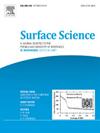Intercalation of Mn in a few layers of NbSe2 by molecular beam epitaxy
IF 1.8
4区 化学
Q3 CHEMISTRY, PHYSICAL
引用次数: 0
Abstract
Modifications of NbSe2 ultrathin films by intercalation of Mn ions is investigated. The synthesis consists of a two-step approach. First NbSe2 ultrathin films are grown by van der Waals epitaxy on either graphite (HOPG) or MoS2 substrates. Optimized growth conditions show that at low growth temperatures of 250 °C phase-pure NbSe2 is obtained. These films are then modified by a topotactical reaction with small amounts of vapor deposited Mn atoms. It is shown by combination of x-ray photoemission spectroscopy and low energy He-ion scattering spectroscopy that 0.2 to 0.3 monolayer-equivalent amounts of Mn atoms can react with the NbSe2 and intercalate in between NbSe2 layers before Mn adsorption occurs at the surface. The intercalation is confirmed by scanning tunneling microscopy (STM). The Mn ions remain disordered in the intercalation layer as evidenced by STM and low energy electron diffraction. Although the Mn2+ ions are in a high spin state long range magnetic ordering may be frustrated by the structural disorder. Nevertheless, the demonstration of hetero-TM intercalation into TMD layers is an important step in the synthesis of van der Waals crystals modified by elements with large magnetic moments.

用分子束外延技术在NbSe2中嵌入Mn
研究了Mn离子对NbSe2超薄膜的修饰作用。这种综合包括两步方法。首先在石墨(HOPG)或MoS2衬底上通过范德华外延生长NbSe2超薄膜。优化后的生长条件表明,在250℃的低生长温度下,可以得到相纯的NbSe2。这些薄膜然后通过与少量气相沉积Mn原子的拓扑反应进行修饰。结合x射线光发射光谱和低能氦离子散射光谱分析表明,在NbSe2表面发生Mn吸附之前,可以有0.2 ~ 0.3个单层当量的Mn原子与NbSe2发生反应并插入到NbSe2层之间。通过扫描隧道显微镜(STM)证实了该插层。STM和低能电子衍射表明,Mn离子在插层中保持无序状态。虽然Mn2+离子处于高自旋态,但其结构的无序性可能会影响其长程磁有序。然而,证明异质tm嵌入TMD层是合成由大磁矩元素修饰的范德华晶体的重要一步。
本文章由计算机程序翻译,如有差异,请以英文原文为准。
求助全文
约1分钟内获得全文
求助全文
来源期刊

Surface Science
化学-物理:凝聚态物理
CiteScore
3.30
自引率
5.30%
发文量
137
审稿时长
25 days
期刊介绍:
Surface Science is devoted to elucidating the fundamental aspects of chemistry and physics occurring at a wide range of surfaces and interfaces and to disseminating this knowledge fast. The journal welcomes a broad spectrum of topics, including but not limited to:
• model systems (e.g. in Ultra High Vacuum) under well-controlled reactive conditions
• nanoscale science and engineering, including manipulation of matter at the atomic/molecular scale and assembly phenomena
• reactivity of surfaces as related to various applied areas including heterogeneous catalysis, chemistry at electrified interfaces, and semiconductors functionalization
• phenomena at interfaces relevant to energy storage and conversion, and fuels production and utilization
• surface reactivity for environmental protection and pollution remediation
• interactions at surfaces of soft matter, including polymers and biomaterials.
Both experimental and theoretical work, including modeling, is within the scope of the journal. Work published in Surface Science reaches a wide readership, from chemistry and physics to biology and materials science and engineering, providing an excellent forum for cross-fertilization of ideas and broad dissemination of scientific discoveries.
 求助内容:
求助内容: 应助结果提醒方式:
应助结果提醒方式:


